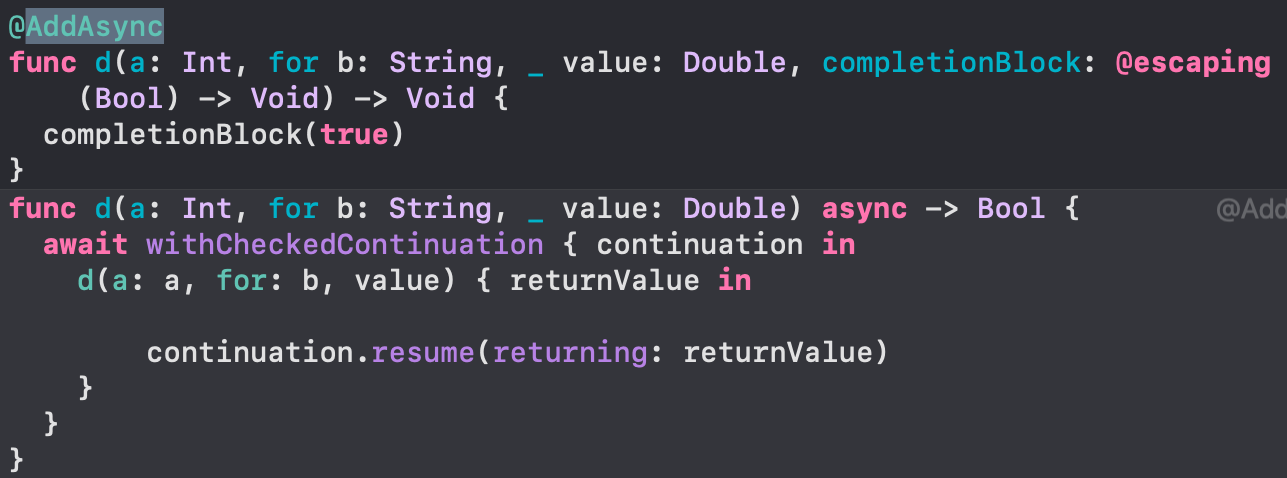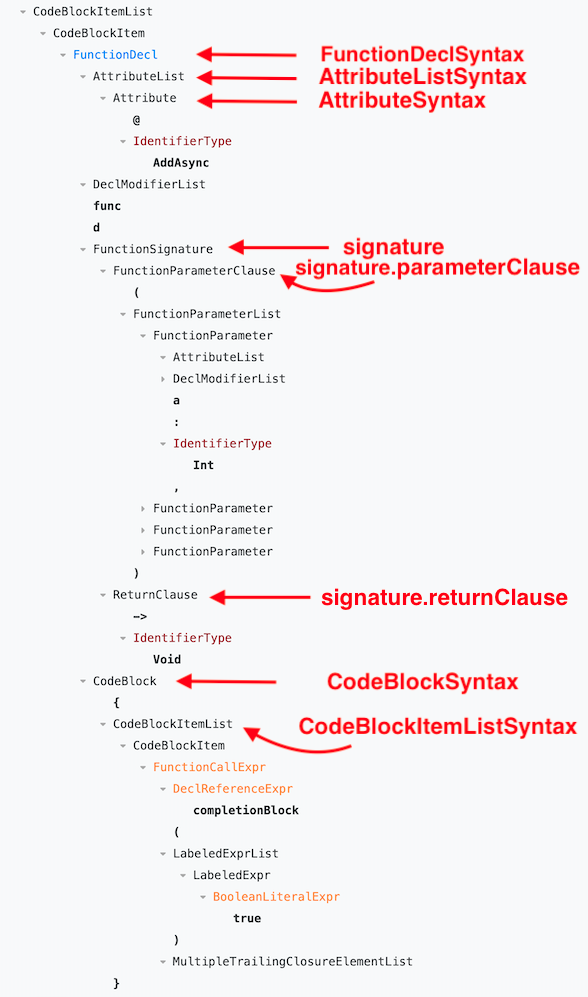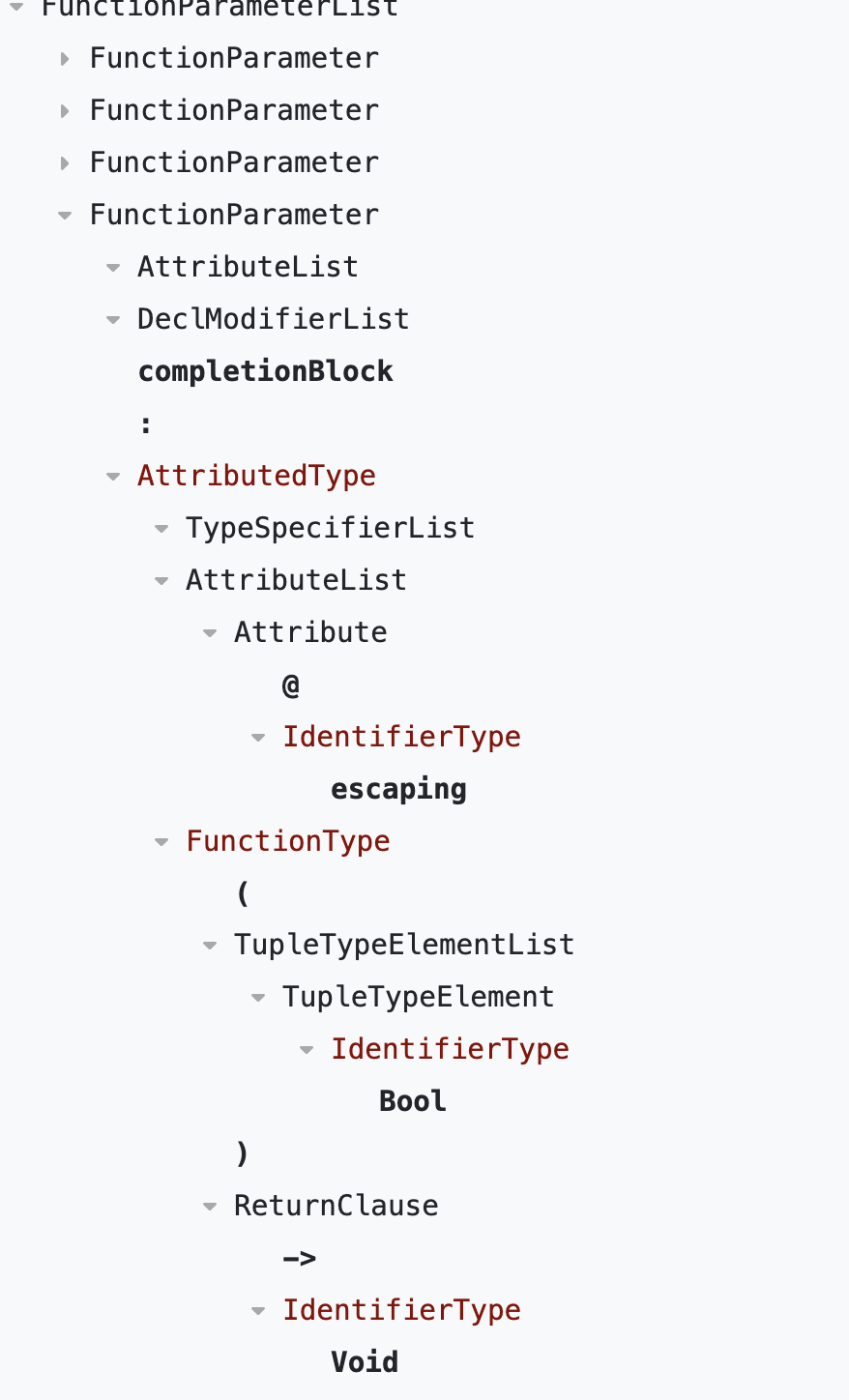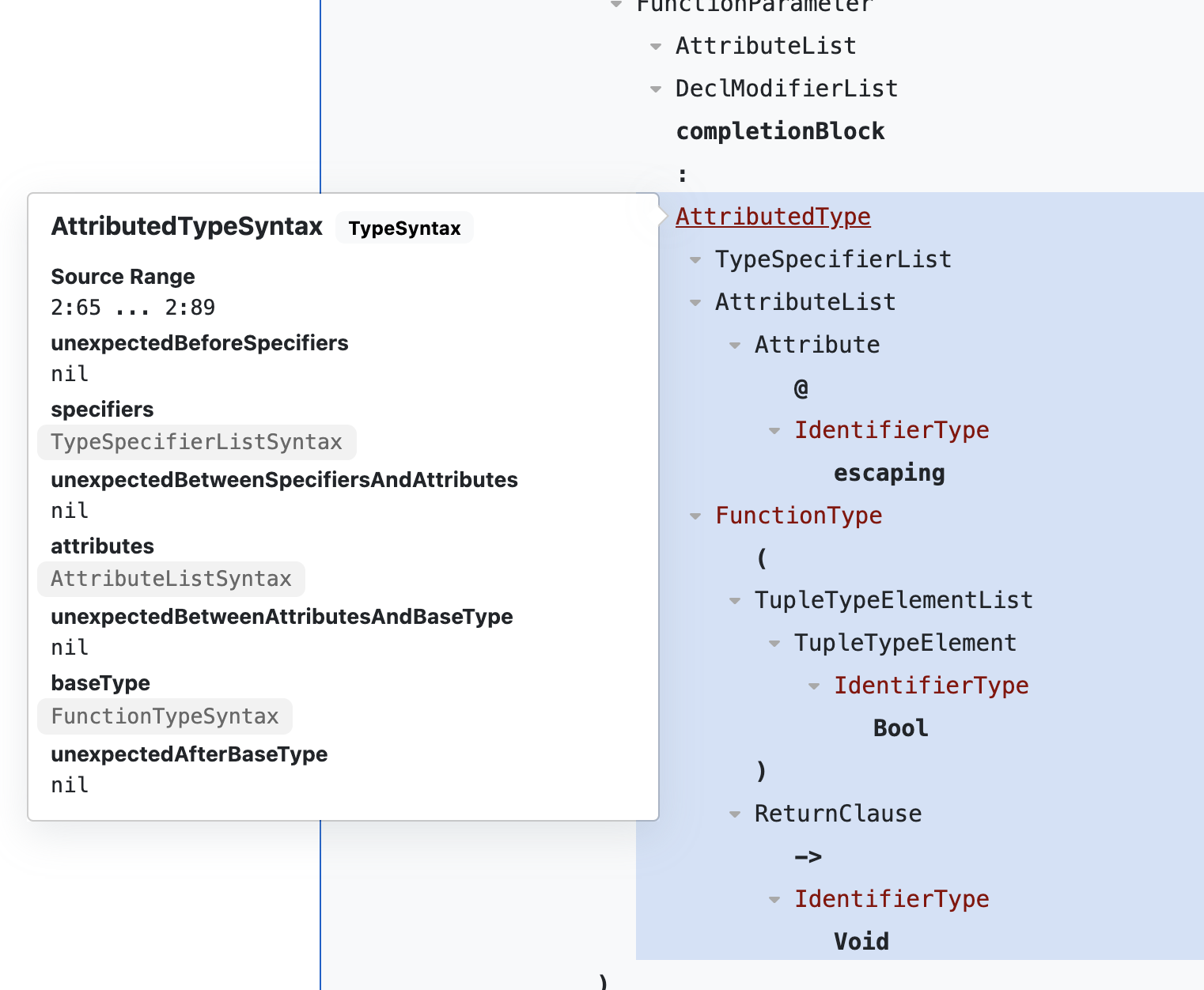Swift Macro系列2-实践篇@attached(peer)
Contents
本文是《Swift Macro系列》的第二篇,旨在通过详细的步骤和代码示例,指导读者如何设计和实现一个@attached(peer)宏。我们将从宏的基本功能分析开始,逐步深入到expansion函数的实现,并探讨如何通过SwiftSyntax库来操作抽象语法树(AST)。
实现宏的流程
1.分析设计宏要实现的功能是什么?
- 确定是要为现有结构增加功能(此时应使用关联宏),还是实现一个完全独立的新功能(此时应使用独立宏)。
2.遵守对应宏协议,实现expansion函数
- 分析源代码结构的函数declaration是类型/扩展,还是函数? 是否符合当前宏的使用条件,即进行类型判断,安全防护,抛出错误处理。
- 通过分析现有类型的AST结构,添加需要实现的功能。一般包括:函数签名和返回类型提取;函数名称提取;
- 从新的声明中移除宏声明,即
@xxxx或#xxxxx这类在源代码开头添加的宏,避免宏被重复展开。 - 设置新声明参数,生成新声明。
@attached(peer)
Peer Macros是一种宏,它能够在相同作用域内为现有声明生成新的声明,特别适用于增强代码组织和可维护性。
这个角色除了能关联到常见的类型、参数、方法以外,甚至能关联 import 和操作符的声明,并为其添加新的声明。以下面的方法为例,
定义了一个 Swift 宏 AddAsyncMacro,它是一个用于扩展非异步函数以支持 async 属性的宏。在这个例子中,AddAsyncMacro 会在原始的非异步函数上生成一个新的 async 函数版本。
添加后的展开效果如图所示:

由于我们是在相同作用域在添加新的函数,所以适合使用关联宏peer类型,
接下来实现PeerMacro协议,即实现expansion函数,不同的协议类型,需要分别实现不同参数的expansion函数。
public protocol PeerMacro: AttachedMacro {
static func expansion(
of node: AttributeSyntax,
providingPeersOf declaration: some DeclSyntaxProtocol,
in context: some MacroExpansionContext
) throws -> [DeclSyntax]
}
解释其中参数和返回值含义:
of node: AttributeSyntax: 此参数代表宏的属性语法节点,也就是代码中应用的宏标签。在 AST(抽象语法树)中,它对应于代表该宏Attribute的位置。providingPeersOf declaration: some DeclSyntaxProtocol:此参数代表应用宏的声明语法节点。在 AST 中,它通常对应于一个具体的声明节点,如函数声明 (FunctionDecl) 或变量声明 (VarDecl)。这个参数提供了宏操作的目标,你可以在其中创建新的“同类”声明。in context: some MacroExpansionContext:此参数提供宏扩展执行的上下文信息,包含可用的符号、诊断信息等。虽然它不直接对应于 AST 中的一个节点,但它为宏的扩展过程提供环境支持。- 返回值是
DeclSyntax类型数组,DeclSyntax就是专门用来表示声明(Declarations)的节点类型。声明可以是变量、函数、类、结构体、枚举等 Swift 代码中的元素。因此,返回值代表你要添加的内容结构。
在分析时,在实现expansion函数之前,我们通常会使用工具如Swift AST Explorer来分析源代码结构,这有助于我们更好地理解AST并实现宏。
首先利用Swift AST Explorer,分析源代码结构
@AddAsync
func d(a: Int, for b: String, _ value: Double, completionBlock: @escaping (Bool) -> Void) -> Void {
completionBlock(true)
}
函数AST结构如下图所示,添加了关键的标注信息,对应SwiftSynatx中对应的类型或结构字段名

首先简要分析此AST结构
- CodeBlockItemList:这是一个包含多个代码块项目的列表。
- CodeBlockItem:这是CodeBlockItemList中的一个项目。
- FunctionDecl:这是一个函数声明。
- AttributeList:这是一个宏的属性列表,包含了修饰函数的宏的信息。 Attribute:这是一个属性。 @:这是一个属性标记,表示该参数是逃逸的。 IdentifierType:这是一个标识符类型。
- DeclModifierList:这是一个声明修饰符列表,包含了函数的修饰符。 func:这是函数关键字。 d:这是函数的名称。
- FunctionSignature:这是函数签名。
- FunctionParameterClause:这是函数参数的括号部分。
- FunctionParameterList:这是函数参数的列表。
- FunctionParameter:这是单个函数参数。
结合实现expansion函数的流程,将一步步展示如何实现这个功能的PeerMacro
- 判断声明类型应该是函数,否则抛出错误
// Only on functions at the moment.
guard var funcDecl = declaration.as(FunctionDeclSyntax.self) else {
throw CustomError.message("@addAsync only works on functions")
}
expansion函数的declaration参数类型是DeclSyntaxProtocol,是通用类型,而函数类型FunctionDeclSyntax是遵循DeclSyntaxProtocol的结构体,所示需要使用as进行类型转换
-
特定限制检查,该宏应用于满足特定条件的函数,包括:不是异步函数;将completion处理程序作为最后一个参数并返回Void。
此处需要重点分析AST结构中,signature下面的parameterClause和returnClause参数,
- parameterClause参数是FunctionParameterClauseSyntax类型,也是遵循SyntaxProtocol的结构体,该结构体通常用于解析和生成 Swift 代码中的函数参数子句,例如函数的参数列表部分。
- parameterClause.parameters是FunctionParameterListSyntax类型,是一个集合类型,查看AST图片结构中可以看到多个FunctionParameter,其中每一个参数就是一个FunctionParameterSyntax结构体,用于表示 Swift 语法中的函数参数。例如当前示例中d函数参数
a: Int,参数b: String。 - returnClause参数是ReturnClauseSyntax类型,
ReturnClauseSyntax是一个结构体,遵循SyntaxProtocol和SyntaxHashable协议,它用于表示 Swift 语法中的返回子句。例如当前示例中d函数返回-> Void可以被解析为一个ReturnClauseSyntax实例,其中Void是返回类型。
// This only makes sense for non async functions.
if funcDecl.signature.effectSpecifiers?.asyncSpecifier != nil {
throw CustomError.message(
"@addAsync requires an non async function"
)
}
// This only makes sense void functions
if funcDecl.signature.returnClause?.type.as(IdentifierTypeSyntax.self)?.name.text != "Void" {
throw CustomError.message(
"@addAsync requires an function that returns void"
)
}
// Requires a completion handler block as last parameter
guard let completionHandlerParameterAttribute = funcDecl.signature.parameterClause.parameters.last?.type.as(AttributedTypeSyntax.self),
let completionHandlerParameter = completionHandlerParameterAttribute.baseType.as(FunctionTypeSyntax.self)
else {
throw CustomError.message(
"@addAsync requires an function that has a completion handler as last parameter"
)
}
// Completion handler needs to return Void
if completionHandlerParameter.returnClause.type.as(IdentifierTypeSyntax.self)?.name.text != "Void" {
throw CustomError.message(
"@addAsync requires an function that has a completion handler that returns Void"
)
}
参数completionHandlerParameterAttribute是signature.parameterClause集合中最后一个元素(即d函数的completionBlock参数)的类型的type就是,如下图所示局部展开的AST中的AttriubutedType字段。

在分析了参数和AST结构之后,我们分享一些有用的AST查看技巧,这将帮助我们更有效地理解和操作AST。
- AST展示的节点名称通常在末尾去掉
Syntax,例如AttributedType实际上代表的是AttributedTypeSyntax。 - 点击AST结构展开或收起,鼠标点中其中节点会在左侧展示对应节点的子属性,这些属性不直接展示在AST结构中。
completionHandlerParameterAttribute的baseType如下图所示,是FunctionType。对应示例中d函数completionBlock: @escaping (Bool) -> Void中闭包参数,即(Bool) -> Void。

- 在分析源代码声明基础上,添加新功能
通过前面分析,completionHandlerParameterAttribute和completionHandlerParameter两个参数,分别拿到completionBlock闭包和其闭包参数,然后返回类型和结果处理:确定返回类型是否为Result类型,如果是则提取Result类型。
let returnType = completionHandlerParameter.parameters.first?.type
//parameters是TupleTypeElementListSyntaxSyntaxCollection,returnType是Void
let isResultReturn = returnType?.children(viewMode: .all).first?.description == "Result"
let successReturnType = isResultReturn ? returnType!.as(IdentifierTypeSyntax.self)!.genericArgumentClause?.arguments.first!.argument : returnType
//
这里特别区分不同
func c(a: Int, for b: String, _ value: Double, completionBlock: @escaping (Result<String, Error>) -> Void) -> Void {
completionBlock(.success("a: \(a), b: \(b), value: \(value)"))
}
转成异步函数,宏会根据闭包的返回类型(Void 或 Result)生成不同的异步函数体。
func c(a: Int, for b: String, _ value: Double) async throws -> String {
try await withCheckedThrowingContinuation { continuation in
c(a: a, for: b, value) { returnValue in
switch returnValue {
case .success(let value):
continuation.resume(returning: value)
case .failure(let error):
continuation.resume(throwing: error)
}
}
}
}
如果闭包返回类型是 Result,使用 try await withCheckedThrowingContinuation 处理可能的错误。修改返回类型为闭包的返回类型(如果是 Result,则提取 Result 的第一个泛型参数)。
如果闭包返回类型是 Void,使用 await withCheckedContinuation 处理无错误的情况。直接调用 continuation.resume(returning: ()) 处理 Void 返回类型。
接下来,移除源代码声明中的completionHandler参数,因为转换后不再需要
// Remove completionHandler and comma from the previous parameter
var newParameterList = funcDecl.signature.parameterClause.parameters
newParameterList.removeLast()
var newParameterListLastParameter = newParameterList.last!
newParameterList.removeLast()
newParameterListLastParameter.trailingTrivia = []
newParameterListLastParameter.trailingComma = nil
newParameterList.append(newParameterListLastParameter)
- 从新的声明中移除宏声明,避免宏被重复展开
let newAttributeList = funcDecl.attributes.filter {
guard case let .attribute(attribute) = $0,
let attributeType = attribute.attributeName.as(IdentifierTypeSyntax.self),
let nodeType = node.attributeName.as(IdentifierTypeSyntax.self)
else {
return true
}
return attributeType.name.text != nodeType.name.text
}
这部分代码完全几乎可以不做修改,在很多同类型Peer宏展开中使用,与具体的功能无关。
5.设置新声明参数,返回新的声明内容。
let callArguments: [String] = newParameterList.map { param in
let argName = param.secondName ?? param.firstName
let paramName = param.firstName
if paramName.text != "_" {
return "\(paramName.text): \(argName.text)"
}
return "\(argName.text)"
}
let switchBody: ExprSyntax =
"""
switch returnValue {
case .success(let value):
continuation.resume(returning: value)
case .failure(let error):
continuation.resume(throwing: error)
}
"""
let newBody: ExprSyntax =
"""
\(raw: isResultReturn ? "try await withCheckedThrowingContinuation { continuation in" : "await withCheckedContinuation { continuation in")
\(raw: funcDecl.name)(\(raw: callArguments.joined(separator: ", "))) { \(raw: returnType != nil ? "returnValue in" : "")
\(raw: isResultReturn ? switchBody : "continuation.resume(returning: \(raw: returnType != nil ? "returnValue" : "()"))")
}
}
"""
在这段代码中,我们首先创建了一个callArguments数组,它包含了新异步函数调用时所需的所有参数。然后,我们根据闭包的返回类型(是否为Result类型)来决定如何生成异步函数体。如果闭包返回Result类型,我们将使用try await withCheckedThrowingContinuation来处理可能的错误,并根据Result的值来决定是继续执行还是抛出错误。如果闭包返回Void类型,我们将使用await withCheckedContinuation来处理无错误的情况。
接下来,我们更新函数声明,添加异步关键字(async),并根据需要添加throws关键字:
// add async
funcDecl.signature.effectSpecifiers = FunctionEffectSpecifiersSyntax(
leadingTrivia: .space,
asyncSpecifier: .keyword(.async),
throwsSpecifier: isResultReturn ? .keyword(.throws) : nil
)
// add result type
if let successReturnType {
funcDecl.signature.returnClause = ReturnClauseSyntax(leadingTrivia: .space, type: successReturnType.with(\.leadingTrivia, .space))
} else {
funcDecl.signature.returnClause = nil
}
// drop completion handler
funcDecl.signature.parameterClause.parameters = newParameterList
funcDecl.signature.parameterClause.trailingTrivia = []
funcDecl.body = CodeBlockSyntax(
leftBrace: .leftBraceToken(leadingTrivia: .space),
statements: CodeBlockItemListSyntax(
[CodeBlockItemSyntax(item: .expr(newBody))]
),
rightBrace: .rightBraceToken(leadingTrivia: .newline)
)
funcDecl.attributes = newAttributeList
funcDecl.leadingTrivia = .newlines(2)
return [DeclSyntax(funcDecl)]
最后,我们更新函数的参数列表,移除原有的completion handler参数,并设置新的函数体和属性:
通过这些步骤,我们成功地将一个非异步函数转换为一个异步函数,并确保了代码的正确性和可读性。
构建由几个层级组层:
- ExprSyntax:表示一个表达式,例如变量赋值、函数调用、算术运算等。
- CodeBlockItemSyntax:表示代码块中的一个条目,可以是语句(StmtSyntax)、声明(DeclSyntax)或表达式(ExprSyntax)。ExprSyntax可以作为 CodeBlockItemSyntax 的一部分,表示代码块中的具体操作。
- CodeBlockSyntax:表示一个代码块,通常包含一系列CodeBlockItemSyntax组成。
- DeclSyntax:表示一个声明,例如函数声明、变量声明、类型声明等。包含 CodeBlockSyntax 作为其主体部分。
通过这种方式,你可以构建复杂的声明、代码块和表达式结构。
小结
在本文中,我们深入探讨了Swift宏的实现流程,特别关注了@attached(peer)宏的详细实践。我们从分析宏的功能需求出发,逐步实现了expansion函数,这是宏实现的核心。通过分析源代码结构,我们学会了如何为现有函数添加新的异步版本,这是通过PeerMacro协议实现的。我们详细讨论了如何检查函数的签名、参数和返回类型,以及如何根据这些信息生成新的声明。此外,我们还学习了如何从源代码中移除宏声明,以避免宏的重复展开,并且设置了新的声明参数,以生成和返回新的声明内容。
通过本文的指导,读者应该能够理解如何在Swift中实现和使用宏,特别是关联宏,以及如何利用SwiftSyntax库来操作和分析抽象语法树(AST)。这些知识不仅有助于提高代码的组织性和可维护性,还能在编译时生成更高效、更简洁的代码。随着Swift语言的不断发展,宏的使用将为开发者提供更多的灵活性和能力,以构建更加强大的Swift应用程序。希望本文能作为您在Swift宏世界中探索和实践的起点,激发您在项目中有效地利用宏的潜力。